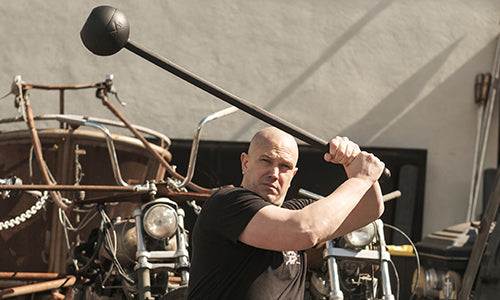Looking for a workout tool that makes you feel like a Viking warrior while building unbreakable strength? Enter the macebell—a piece of old-school weaponry turned functional training powerhouse.
This odd-looking metal club is more than just a cool Instagram prop—it’s a serious tool for grip, shoulder, and core strength. Whether you’re into functional fitness, powerlifting, or just want to swing heavy things like a battle-hardened gladiator, the macebell belongs in your arsenal.
A Brief History of the Macebell
The mace has been around for centuries, originally used as a weapon in battle. Warriors from India, Persia, and Europe wielded heavy maces to develop brute strength and dominate the battlefield.
Eventually, this combat tool found its way into training regimens, particularly in India, where wrestlers and warriors used gada (traditional maces) to build shoulder mobility, endurance, and raw power.
Fast forward to today, and mace training is making a comeback, with lifters, athletes, and home gym warriors recognizing its unique benefits.
What Muscles Do Macebells Target?
The macebell might look like Thor’s hammer, but it works way more than just your arms. Because of its offset weight distribution, it forces your stabilizer muscles to work overtime.
Primary Muscles Worked:
- Shoulders (Delts & Rotator Cuff) – Strengthens and stabilizes for injury-proof shoulders.
- Forearms & Grip – Crushes grip strength by making you fight for control.
- Core (Abs & Obliques) – Forces your midsection to brace and resist rotation.
- Upper Back & Lats – Helps with pulling power and posture.
Depending on the exercises you do, you can also engage your legs, chest, and triceps—making it a full-body workout tool.
How to Use a Macebell
Macebell training is not just about swinging wildly and hoping for the best—it requires control, technique, and patience.
Basic Macebell Exercises
- 360 Swings – The classic move, where you swing the mace around your head in a controlled motion. Great for shoulder mobility and core stability.
- 10-to-2s – Like a 360 swing, but stopping at 10 and 2 o’clock, adding forearm and core engagement.
- Macebell Press – A strict overhead press, challenging your stabilizers thanks to the uneven weight.
- Offset Rows – Hold the mace close to the head for a brutal back and grip workout.
- Mace Squats – Holding the mace in different positions adds instability, forcing your core and legs to work harder.
Start light and gradually progress, focusing on form before load.
Benefits of Macebell Training
So, why should you ditch the dumbbells and swing a mace instead?
1. Builds Shoulder Mobility & Stability
If your shoulders feel tight, weak, or injury-prone, macebell training will fix that. The circular motions improve mobility, endurance, and strength, making them perfect for lifters, wrestlers, and desk warriors alike.
2. Enhances Grip Strength
A thick handle + uneven weight = grip gains galore. Whether you want a stronger deadlift, bench press, or handshake, the mace has you covered.
3. Develops Core Stability
Every mace movement challenges your core—whether it’s resisting rotation, stabilizing an overhead press, or counterbalancing a heavy swing.
4. Trains Functional Strength
Unlike machines that isolate muscles, the mace trains real-world, full-body strength. It improves coordination, balance, and endurance, making you stronger in everyday movements and sports.
5. Fun, Unique, and Badass
Let’s be real—swinging a heavy metal mace makes you feel cool. Plus, it adds variety to your workouts, keeping things fresh and engaging.
What to Look for in a Macebell
Not all maces are created equal—here’s what to consider when choosing one:
1. Weight Selection
- Beginners: Start with 7-10 lbs—trust us, it feels heavier than it sounds.
- Intermediate: Move up to 15-20 lbs once you’ve nailed the technique.
- Advanced: 25+ lbs if you want a serious challenge.
2. Handle Length & Grip
Longer handles increase leverage, making movements harder but more effective. A textured grip prevents slipping when your hands get sweaty.
3. Adjustable vs. Fixed Weight
Fixed-weight maces are great, but an adjustable macebell lets you increase the challenge without buying multiple maces.
Bells of Steel Adjustable Macebell lets you load weight plates up to 55 lbs, making it the only mace you’ll ever need.
Macebell FAQs
What’s the difference between a macebell and a steel club?
Macebells have longer handles and more offset weight, making them harder to control and better for shoulder mobility. Steel clubs are shorter and easier to handle, great for grip and wrist strength.
Is macebell training good for beginners?
Absolutely! Start light, focus on control, and gradually progress. Don’t let your ego pick the weight—even a 10 lb mace will humble you.
Can macebell training replace traditional weightlifting?
Macebells are an amazing supplement, but they won’t replace heavy squats and presses. Think of them as a secret weapon for injury-proof strength, mobility, and conditioning.
How often should I train with a macebell?
2-3 times per week is great for general strength and mobility. If you’re focusing on mace-specific training, you can use it daily with lower intensity work.
Why does swinging a macebell feel so much harder than it looks?
Because it challenges stabilizer muscles that other exercises don’t! The offset weight forces your core, grip, and shoulders to work harder than with dumbbells or barbells.
Conclusion
The macebell is one of the most underrated strength tools out there. Whether you’re looking to bulletproof your shoulders, build insane grip strength, or just feel like a medieval warrior, it deserves a spot in your gym.
If you want one mace to rule them all, check out the Bells of Steel Adjustable Macebell—because why buy multiple maces when one can do it all?




